Cocker Spaniel - Breed Facts & Characteristics
Consistently ranking high on lists of most popular dogs, the English Cocker Spaniel is a beloved breed, especially in its home country of England. Closely linked but separate from its cousin across the pond, the American Cocker Spaniel, the English is characterized by a longer head and snout and a slightly larger frame. Their ears only look like they’re hitting the floor. Easy-going and quite docile, the English Cocker Spaniel has long held a starring role in the pantheon of petdom.
Official name: English Cocker Spaniel
Other names: Cocker Spaniel, English Cocker, Cocker, EC
Origins: Spain
Tendencia a babear
{score 0 out of 5}Necesidades de aseo
{score 0 out of 5}Nivel de muda de pelo:
{score 0 out of 5}Tendencia a ladrar
{score 0 out of 5}Nivel de energía
{score 0 out of 5}Compatibilidad con otras mascotas
{score 0 out of 5}¿Clima cálido?
{score 0 out of 5}¿Clima frío?
{score 0 out of 5}Apto para vivir en departamento
{score 0 out of 5}Puede quedarse solo
{score 0 out of 5}¿Mascota familiar? *
{score 0 out of 5}
| Macho | Hembra |
|---|---|
| Altura | Altura |
| 39 - 41 | 38 - 39 |
| Peso | Peso |
| 13 - 14.5 | 13 - 14.5 |
| Cachorro | Adulto |
|---|---|
| 2 to 12 months | 1 to 7 years |
| Madurez | Adulto mayor |
| 7 to 10 years | From 10 years |
| Bebé | |
| Birth to 2 months | |
Tendencia a babear
{score 0 out of 5}Necesidades de aseo
{score 0 out of 5}Nivel de muda de pelo:
{score 0 out of 5}Tendencia a ladrar
{score 0 out of 5}Nivel de energía
{score 0 out of 5}Compatibilidad con otras mascotas
{score 0 out of 5}¿Clima cálido?
{score 0 out of 5}¿Clima frío?
{score 0 out of 5}Apto para vivir en departamento
{score 0 out of 5}Puede quedarse solo
{score 0 out of 5}¿Mascota familiar? *
{score 0 out of 5}
| Macho | Hembra |
|---|---|
| Altura | Altura |
| 39 - 41 | 38 - 39 |
| Peso | Peso |
| 13 - 14.5 | 13 - 14.5 |
| Cachorro | Adulto |
|---|---|
| 2 to 12 months | 1 to 7 years |
| Madurez | Adulto mayor |
| 7 to 10 years | From 10 years |
| Bebé | |
| Birth to 2 months | |
Tailored nutrition for your English Cocker Spaniel
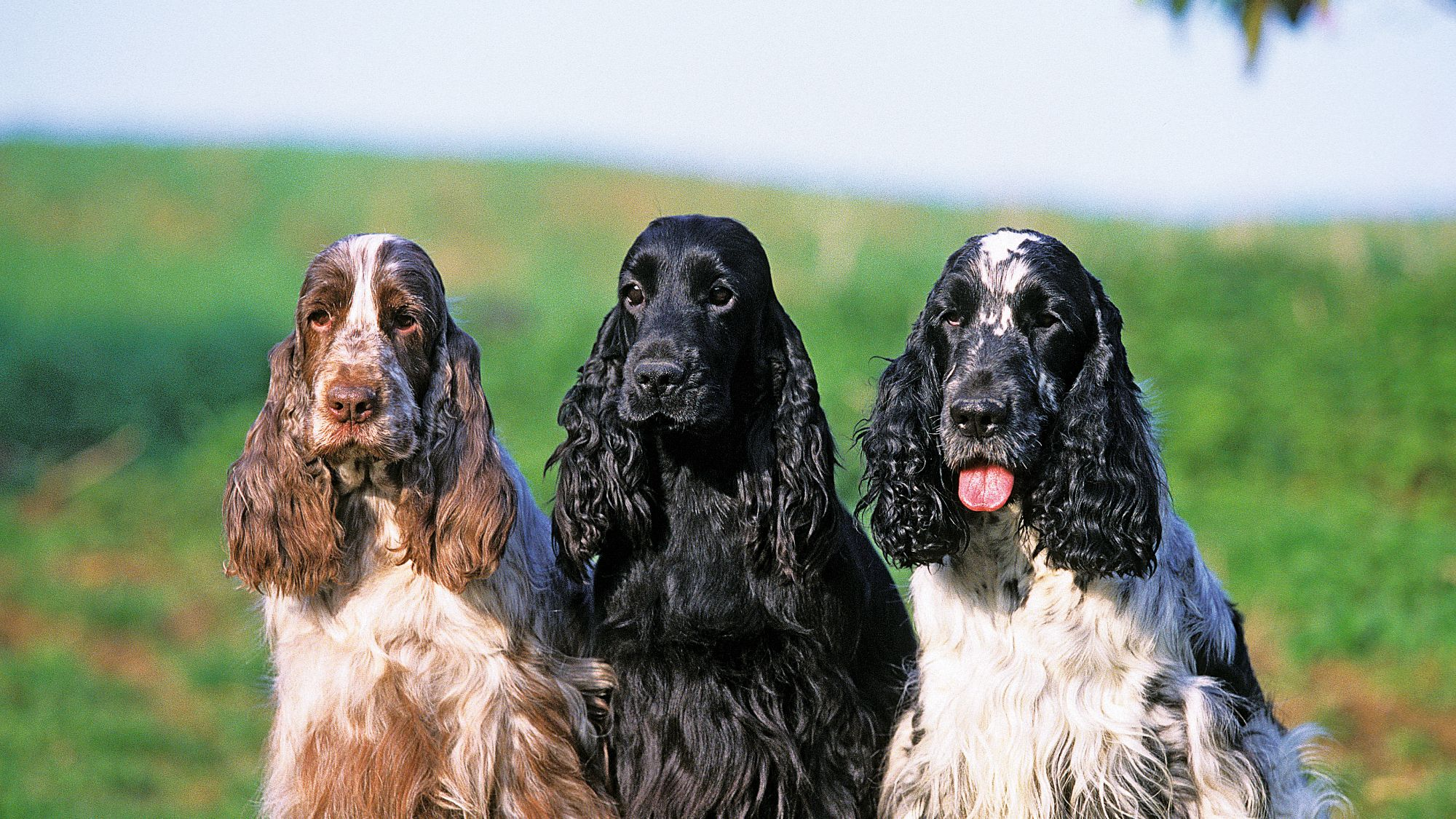
Get to know the English Cocker Spaniel
All you need to know about the breed
Don’t let the posh coat fool you: The English Cocker Spaniel is as rugged as they are captivating, suited to the great outdoors having been bred as a hunting dog. An ever-faithful companion, they’re always eager for a long walk, or even a hike, no matter the weather. The main attraction, besides the chance to stomp around in nature? You. Whether out and about or cosied up by the fire, the breed is never not content to be around his humans. They are devoted by nature.
Using gentle yet firm training from a young age will help entrust your English Cocker Spaniel. The breed can have a mind of its own and with hunting as its instinct, they can sometimes be undecided about coming when called. The English Cocker Spaniel bark can be an issue as it can be for any hunting breed but here, too, training can help.
The English Cocker Spaniel earned its reputation as an expert retriever of game birds, thus known as a bird dog or a gun dog. The smallest of the Sporting Group, their instinctual drive to find and retrieve could translate to picking up objects on the homefront and carrying to another spot. Try a healthy game of fetch if your dog seems restless. Steadiness is the breed hallmark, and their stable bodies will glide through the field or the yard with the greatest of ease.
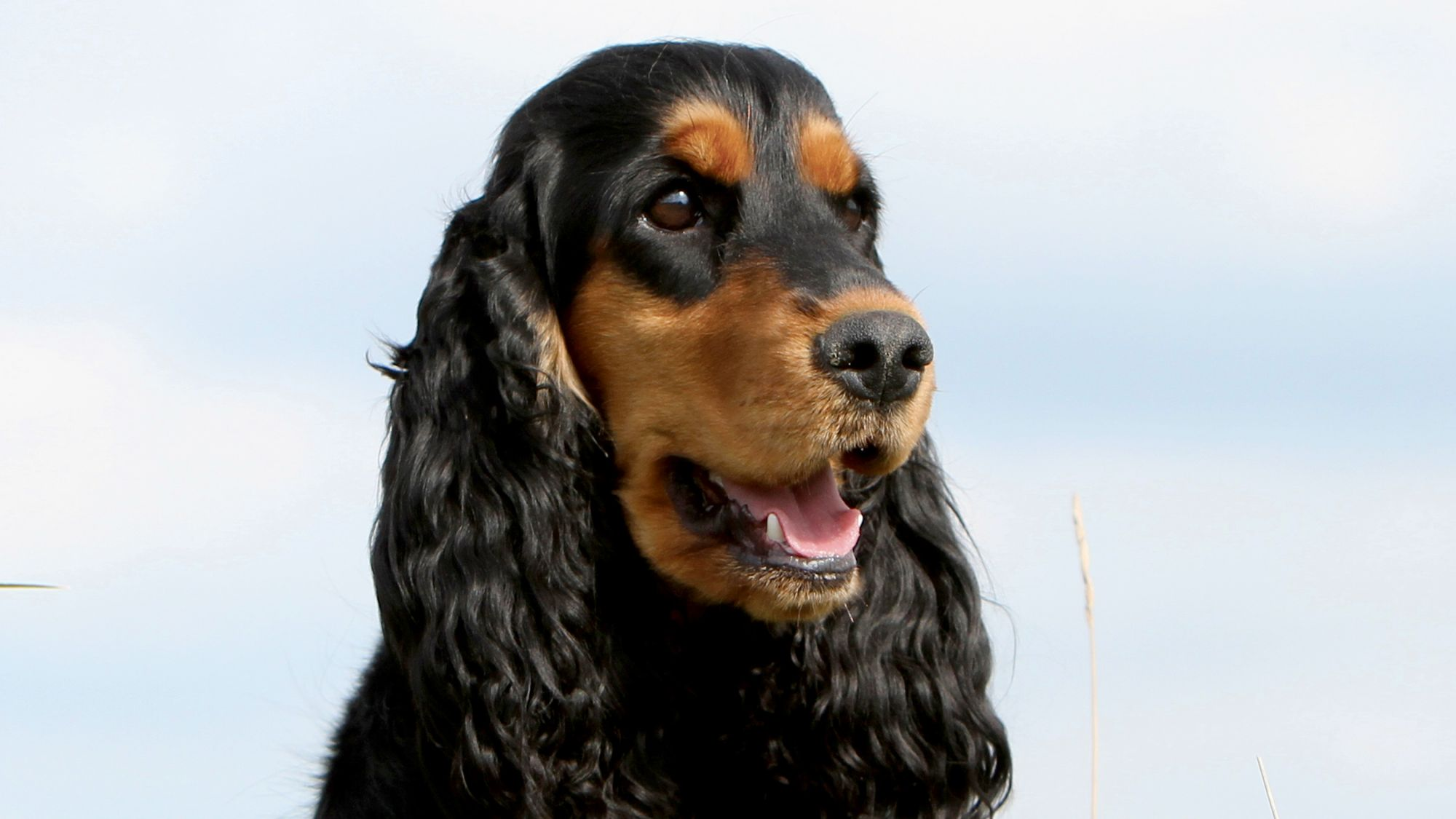
2 facts about English Cocker Spaniels
1. Those silky ears are prone to infection
As with many long-eared breeds, keeping the canals free and clear is a must. Clean them at home and have them thoroughly checked at your vet’s office so your English Cocker Spaniel is well-groomed.
2. Taking its name
The English Cocker Spaniel derives its name from the woodcock
bird, which he is known to be expert at catching.
History of the breed
The English Cocker Spaniel emanated from a sporting past. Developed as a bird dog or gun dog, the breed was used widely throughout England and Europe to retrieve small feathered friends, particularly woodcock from which the breed derives their name. A utility dog, English Cocker Spaniels are thought to be the oldest.
The breed can trace its origins back to Spain, the word “Spaniel” actually meaning “Spanish dog.” English Cocker Spaniels gained tremendous popularity throughout Europe over the ages for their acumen as sporting dogs and with birds before the invention of the rifle. Spaniels are classified as either water Spaniels or land Spaniels, specialised in the intricacies of hunting in either milieu, with the English being the smallest of the land variety. The dogs went on to flourish in England in the 19th Century when showing was in full swing and breed standards started to be established. For both their temperament and personality, the English Cocker Spaniel soon stood out from the pack of various Spaniels.
The breed then diverged on the breeding track from their American cousin as the 20th Century took hold, with both established as official breeds by the American Kennel Club in 1946. The English distinguishes itself with a longer head and nose and shorter-haired coat.
The breed gained tremendous popularity as well with the 1955 Disney movie Lady and the Tramp, with Lady portrayed as an elegant and warm Cocker Spaniel.
From head to tail
Physical characteristics of English Cocker Spaniels
1.Ears
2.Head
3.Body
4.Tail
5.Coat

Things to look out for
From specific breed traits to a general health overview, here are some interesting facts about your English Cocker Spaniel
Reign in the independent streak
Often described as merry, the English Cocker Spaniel’s admirable traits are numerous. Their willful nature is one of them. Until they get distracted and head off in the opposite direction. Early training will help teach them who the alpha is, and is not.
Sometimes difficult to housetrain
As a breed that’s obstinate and used to sport, issues can arise when it comes to training the English Cocker Spaniel. A crate can be a great aid in reinforcing good, and discouraging bad, behaviour.
Underneath that soft exterior lurks the body of a champion athlete
As domesticated as they are, the breed is also a sporting one. Exercise for the English Cocker Spaniel then, is essential. They enjoy hikes in the great outdoors and will never turn their noses up at playtime in the yard.
Healthy diet, healthier dog
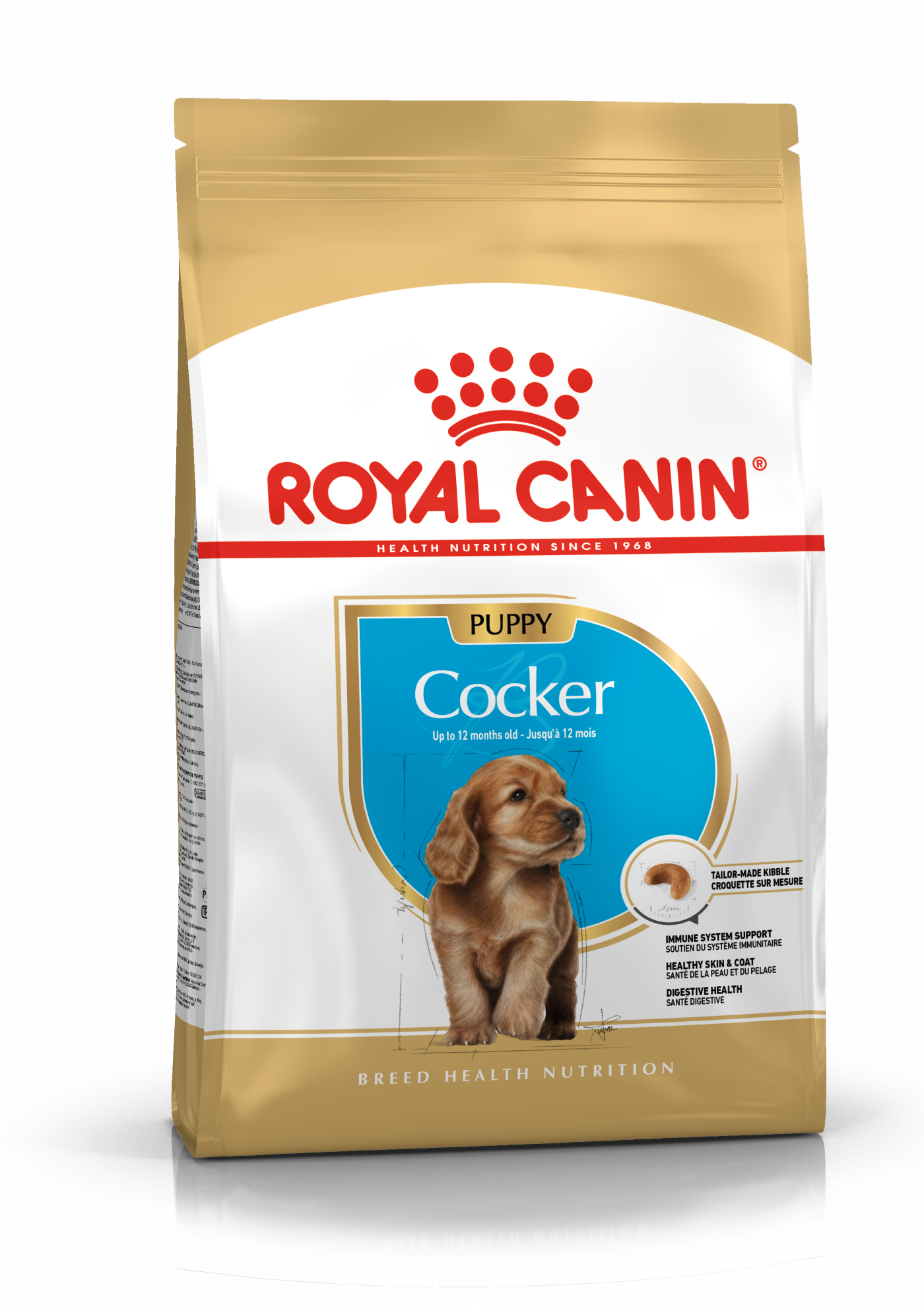
When choosing food for an English Cocker Spaniel, there are many factors to consider: their age, lifestyle, activity level, physiological condition, and health including potential sickness or sensitivities. Food provides energy to cover a dog’s vital functions, and a complete nutritional formula should contain an adjusted balance of nutrients to avoid any deficiency or excess in their diet, both of which could have adverse effects on the dog.
Clean and fresh water should be available at all times. In hot weather and especially when out exercising, bring water along for your dog’s frequent water breaks.
Energy intake will always have to be adapted to the climatic conditions. A dog that lives outdoors in winter will have increased energy requirements.
The following recommendations are for healthy animals. If your dog has health problems, please consult your veterinarian who will prescribe an exclusive veterinary diet.
An English Cocker Spaniel puppy’s requirements, in terms of energy, protein, minerals, and vitamins, are much greater than those of an adult dog. They need energy and nutrients to maintain their body, but also to grow and build it. Until they are 12 months old, an English Cocker Spaniel puppy's immune system develops gradually. A complex of antioxidants - including vitamin E - can help support their natural defences during this time of big changes, discoveries, and new encounters. Their digestive functions are different from an adult English Cocker Spaniel’s, too: their digestive system is not mature yet so it’s important to provide highly digestible proteins that will be effectively used. Prebiotics, such as fructo-oligosaccharides, support digestive health by helping balance the intestinal flora, resulting in good stool quality.
Similarly, a puppy’s teeth – starting with the milk teeth, or first teeth, then the permanent teeth – are an important factor that needs to be taken into account when choosing the size, form, and hardness of kibble. The maintenance of the health of an English Cocker Spaniels’ skin and coat requires key nutrients, such as omega-3 fatty acids (EPA-DHA), vitamin A, and borage oil. This short growth phase also means high energy needs, so the food must have a high energy content (expressed in Kcal/100g of food), while concentrations of all other nutrients will also be higher than normal in a specially formulated growth food. It is recommended to split the daily allowance into three meals until they are six months old, then to switch to two meals per day.
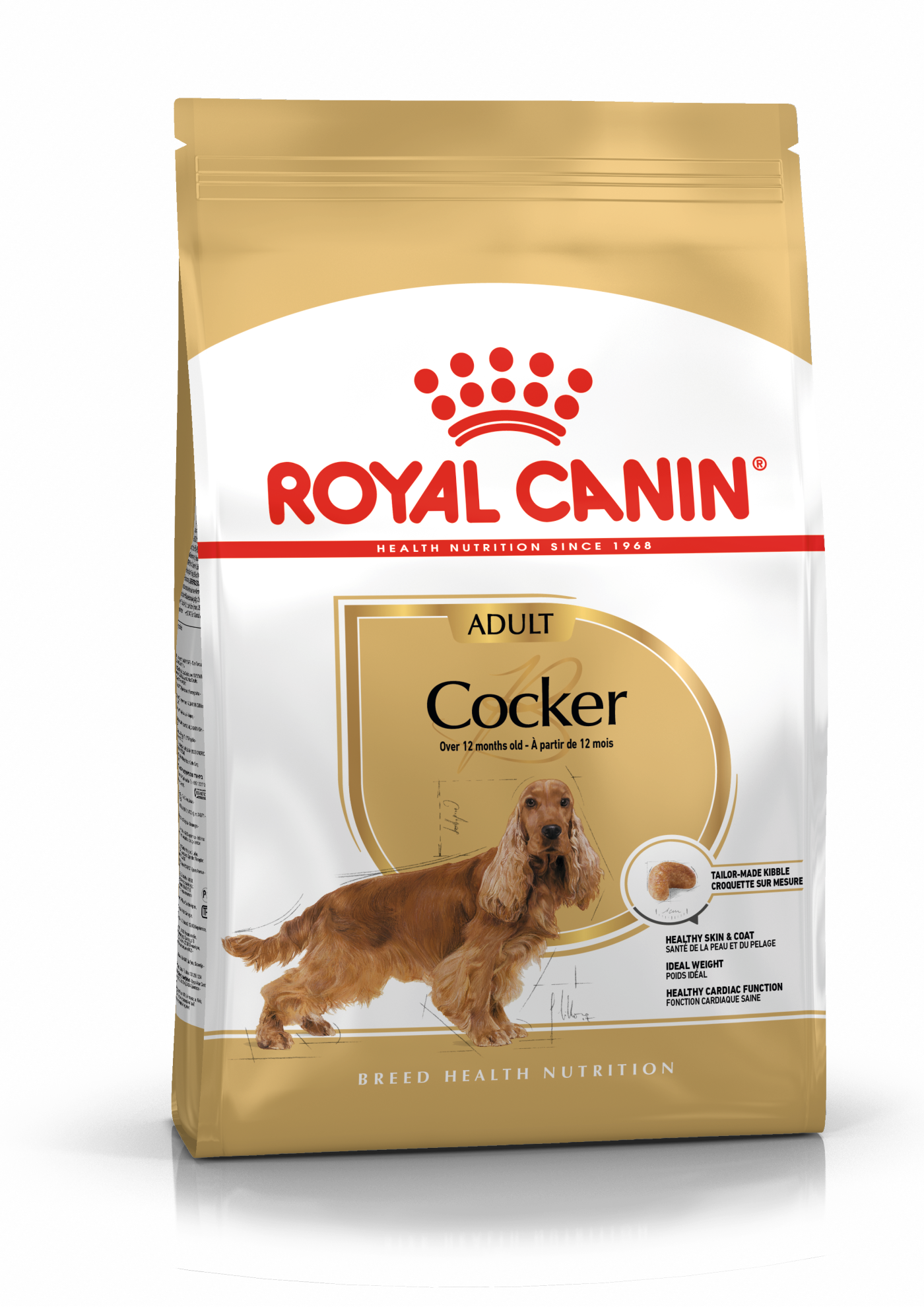
The main nutritional goals for adult English Cocker Spaniels are:
Maintaining healthy skin by strengthening the effectiveness of the skin barrier with the enriched addition of essential fatty acids (especially EPA-DHA), essential amino acids, and B vitamins
Maintaining an ideal body weight by using highly digestible ingredients and keeping the fat content at a sensible level. English Cocker Spaniels are known to be greedy. Maintaining a healthy weight in this breed is a vital health issue.
Helping support good cardiac function with an adjusted content of minerals, EPA-DHA, taurine, L-carnitine, and antioxidants
Promoting optimal digestibility with high quality protein and a balanced supply of dietary fibre.
To help support their natural defences, a formula enriched with an antioxidant complex and containing mannan-oligosaccharides is recommended.

After 7 years old, English Cocker Spaniels start facing the first signs of ageing. A formula enriched with antioxidants will help maintain their vitality, and specific nutrients, such as chondroitin, and glucosamine, will help maintain healthy bones and joints. Ageing is also accompanied by the modification of digestive capacities and particular nutritional requirements, so food for older English Cocker Spaniels should have the following characteristics:
Higher vitamin C and E content. These nutrients have antioxidant properties, helping to protect the body’s cells against the harmful effects of the oxidative stress linked to ageing
High-quality protein. Contrary to a widely held misconception, lowering the protein content in food brings little benefit in limiting kidney failure. On top of it, older dogs are less efficient at using dietary protein than younger dogs. Reducing the phosphorus content is a good way of slowing down the gradual deterioration of kidney function.
A higher proportion of the trace elements iron, copper, zinc, and manganese to help maintain good condition of the skin and coat.
A higher quantity of polyunsaturated fatty acids (omega-3 and omega-6 fatty acids) to maintain the quality of the coat. Dogs can normally produce these fatty acids, but ageing can affect this physiological process.
As they age, dogs increasingly suffer from teeth problems. To ensure they continue to eat in sufficient quantities, the size, shape, and texture of their kibble need to be tailored to their jaw. An adapted kibble shape may help reduce the rate of food intake to help your dog maintain a healthy body weight.
Throughout their life, it is important to avoid feeding English Cocker Spaniels human foods or fatty snacks. Instead, reward them with kibble taken from their daily meal allowance, and strictly follow the feeding guidelines written on the package in order to prevent excessive weight gain.
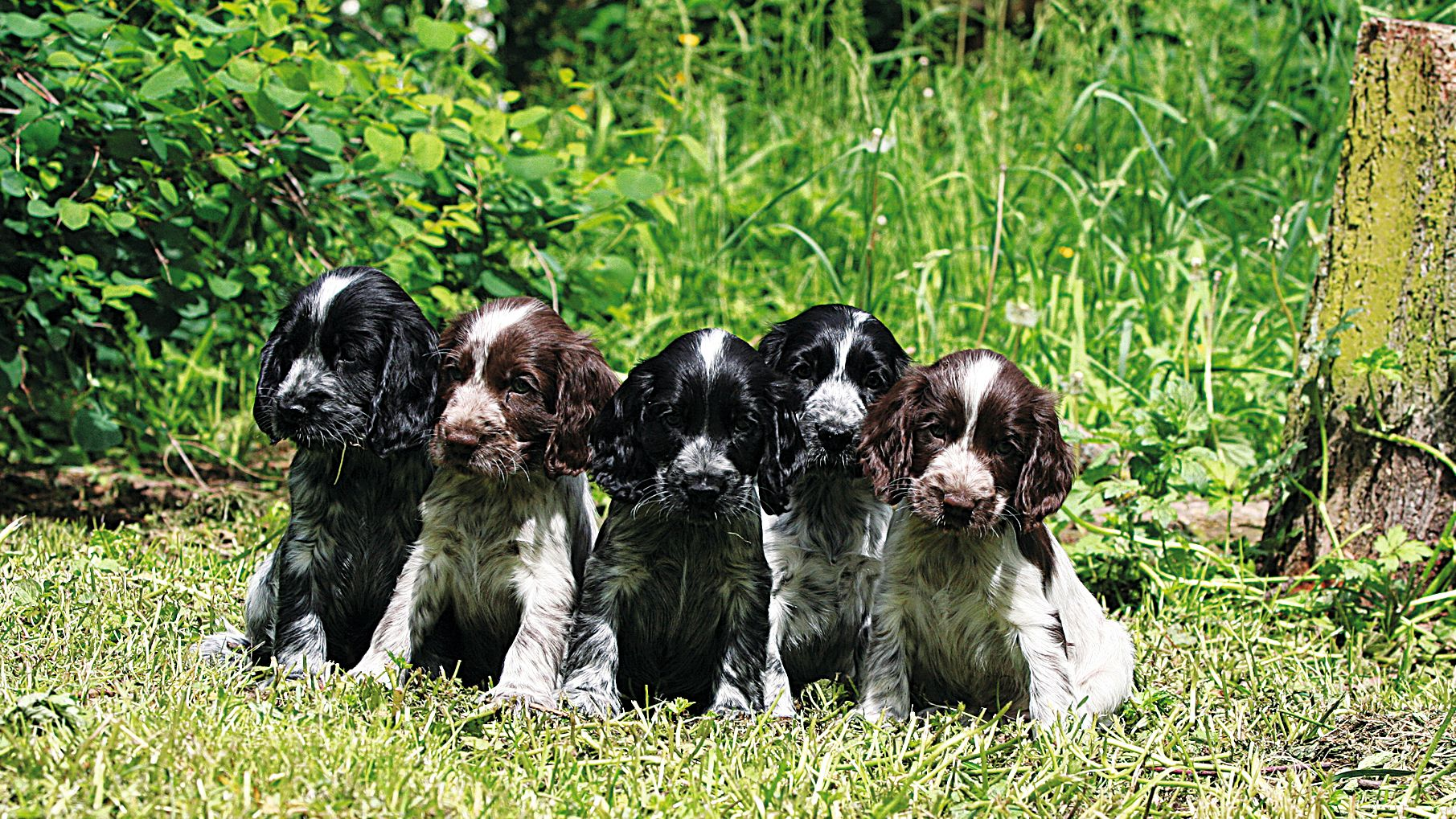
Caring for your English Cocker Spaniel
Grooming, training and exercise tips
English Cocker Spaniels enjoy exercise, including runs and long walks, and should get some in every day. As a hunting breed, they are used to being outdoors. Romps in the yard with the family (the English Cocker Spaniel is kid-friendly!) work as well since the breed enjoys playtime tremendously.
The English Cocker Spaniel’s coat is their most distinguishing attribute. Glossy and fine, the breed’s short, tight, wavy hair has made it the highlight of dog shows for decades, and garnered it the top prize many times over. Brushing and combing once a week will keep it in top form. Groom your Cocker Spaniel with a professional for hard-to-get-right areas around the face and feet, and under the neck, ears, and tail where hair can be longer. Your dog will thank you for it.
As with many purebred dogs whose traits are intact, training should come early. Highly sensitive dogs, training English Cocker Spaniels with a patient, gentle hand is best. Consistency is key, harshness is not. Their softness extends to the inside as well as the outside.
English Cocker Spaniels enjoy exercise, including runs and long walks, and should get some in every day. As a hunting breed, they are used to being outdoors. Romps in the yard with the family (the English Cocker Spaniel is kid-friendly!) work as well since the breed enjoys playtime tremendously.
The English Cocker Spaniel’s coat is their most distinguishing attribute. Glossy and fine, the breed’s short, tight, wavy hair has made it the highlight of dog shows for decades, and garnered it the top prize many times over. Brushing and combing once a week will keep it in top form. Groom your Cocker Spaniel with a professional for hard-to-get-right areas around the face and feet, and under the neck, ears, and tail where hair can be longer. Your dog will thank you for it.
As with many purebred dogs whose traits are intact, training should come early. Highly sensitive dogs, training English Cocker Spaniels with a patient, gentle hand is best. Consistency is key, harshness is not. Their softness extends to the inside as well as the outside.
7/7
All about English Cocker Spaniels
The breed is one that’s known
to bark, especially if left indoors. This is an active dog that benefits from
getting outside. Using their voice is a Cocker Spaniel trait and may merely be
their asking to be heard. The very sensitive breed craves the company of their
family and will thrive most with owners who are present a lot of the time.
A sweet breed, the English Cocker Spaniel
is ever-affectionate and has a real desire to be by its owners’ side. They
adore snuggling and are eager to please.
Other breeds that might interest you
Read more on this topic
Sources
- Veterinary Centers of America https://vcahospitals.com/
- Royal Canin Dog Encyclopaedia. Ed 2010 and 2020
- Banfield Pet Hospital https://www.banfield.com/
- Royal Canin BHN Product Book
- American Kennel Club https://www.akc.org/
Like & share this page